The Museum Collection: Roman
.
Bradford on Avon Museum does not hold excavated material from organised archaeological digs such as those at the Atworth and St Laurence School Roman villa sites. Objects excavated there are held by the Wiltshire Museum in Devizes, except for the St Laurence material from 2002 and 2003, which is still being examined at Bristol University. Bradford Museum does, however, hold some Roman items that have turned up by chance in gardens and fields.
.
.
Click on the thumbnail pictures for a bigger view
.
 A child’s sarcophagus (stone coffin) which was found in a field near Parsonage Farm, Winsley. It was originally carved from a single block of limestone, but had been broken into several pieces by ploughing. The lid, which would have been another single piece of stone, was not found. It looks as if there might have been a small settlement somewhere nearby. Local amateur archaeologist Adrian Powell, who found the pieces, worked out the 3D jigsaw and reconstructed it.
A child’s sarcophagus (stone coffin) which was found in a field near Parsonage Farm, Winsley. It was originally carved from a single block of limestone, but had been broken into several pieces by ploughing. The lid, which would have been another single piece of stone, was not found. It looks as if there might have been a small settlement somewhere nearby. Local amateur archaeologist Adrian Powell, who found the pieces, worked out the 3D jigsaw and reconstructed it.
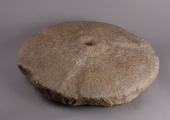 The lower stone of a rotary quern– a type of hand mill for grinding grain into flour for making bread. A missing upper stone would have been turned with a wooden handle and the grain ground between the two. It came from near the important villa at St Laurence School, Budbury, Bradford. It was made from hard quartzite stone, perhaps a sarsen stone from the Marlborough Downs.
The lower stone of a rotary quern– a type of hand mill for grinding grain into flour for making bread. A missing upper stone would have been turned with a wooden handle and the grain ground between the two. It came from near the important villa at St Laurence School, Budbury, Bradford. It was made from hard quartzite stone, perhaps a sarsen stone from the Marlborough Downs.
.
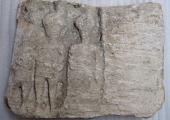 A crude sculpture of a female figure, perhaps a celtic deity, with two attendants, possibly male. It was built into the wall of a building in St Margaret’s Street, Bradford and has been identified as Romano-British, but it is not known why it would have been in that location. Similar carved groups have been found in several places in the Celtic world, frequently in the Cotswolds. It was carved from a piece of Forest Marble shelly oolitic limestone and could have been made locally. It was probably originally wider, with a third attendant and another panel on the left. The face of the stone was trimmed with an axe when it was reused, so that some of the detail of the figures has been lost and there may have been something on the right panel (and possible left side too).
A crude sculpture of a female figure, perhaps a celtic deity, with two attendants, possibly male. It was built into the wall of a building in St Margaret’s Street, Bradford and has been identified as Romano-British, but it is not known why it would have been in that location. Similar carved groups have been found in several places in the Celtic world, frequently in the Cotswolds. It was carved from a piece of Forest Marble shelly oolitic limestone and could have been made locally. It was probably originally wider, with a third attendant and another panel on the left. The face of the stone was trimmed with an axe when it was reused, so that some of the detail of the figures has been lost and there may have been something on the right panel (and possible left side too).
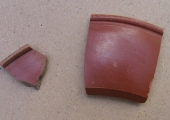 Pieces of Samian ware, an expensive type of pottery with a shiny red coating, that was imported from Gaul (Gallia, modern France). This sort of pottery would have been expensive and beyond the average Romano-Brit, so the places where it is found usually indicate that there had been a substantial house nearby, in this case near Cumberwell, to the north of Bradford.
Pieces of Samian ware, an expensive type of pottery with a shiny red coating, that was imported from Gaul (Gallia, modern France). This sort of pottery would have been expensive and beyond the average Romano-Brit, so the places where it is found usually indicate that there had been a substantial house nearby, in this case near Cumberwell, to the north of Bradford.
.
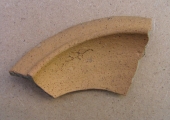 A fragment of a type of pottery called a mortarium in Latin. It is a well-made substantial piece of kitchen-ware that has had grains of sand fixed into the interior surface of the bowl to help in grinding herbs and spices for preparing food. This piece was found in field-walking near Cumberwell.
A fragment of a type of pottery called a mortarium in Latin. It is a well-made substantial piece of kitchen-ware that has had grains of sand fixed into the interior surface of the bowl to help in grinding herbs and spices for preparing food. This piece was found in field-walking near Cumberwell.
.
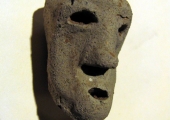 This small pottery head was found in a garden in Downs View, Bradford, not far from the St Laurence School Roman villa in Bradford. It is thought that it was probably part of the decorative handle of a jug, although it could easily have been part of a toy or even of a crude religious statuette.
This small pottery head was found in a garden in Downs View, Bradford, not far from the St Laurence School Roman villa in Bradford. It is thought that it was probably part of the decorative handle of a jug, although it could easily have been part of a toy or even of a crude religious statuette.
..
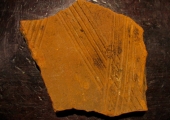 A fragment of a box tile (tubulus in Latin) from near the St Laurence villa, Budbury, Bradford. Box tiles were rectangular-section terracotta pipes that were built into walls, so that hot air from underfloor heating would warm them. The pattern was scratched into the unfired clay to act as a key for plastering the wall.
A fragment of a box tile (tubulus in Latin) from near the St Laurence villa, Budbury, Bradford. Box tiles were rectangular-section terracotta pipes that were built into walls, so that hot air from underfloor heating would warm them. The pattern was scratched into the unfired clay to act as a key for plastering the wall.
.
.
 A copper alloy Roman coin showing the head of Marcus Aurelius Valerius Maximianus Herculius (Maximian), who reigned as the Roman co-emperor between 286 and 310. It was found near Winsley.
A copper alloy Roman coin showing the head of Marcus Aurelius Valerius Maximianus Herculius (Maximian), who reigned as the Roman co-emperor between 286 and 310. It was found near Winsley.
.
.
.
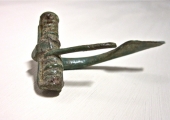 A bronze bow brooch that was found in a field near the St Laurence School villa site. It would have been used to fasten an article of clothing, such as a cloak and worked like a safety pin, with a sprung pin the tip of which has broken off. It is of a type that dates from the late 1st century AD, early in the Roman Period.
A bronze bow brooch that was found in a field near the St Laurence School villa site. It would have been used to fasten an article of clothing, such as a cloak and worked like a safety pin, with a sprung pin the tip of which has broken off. It is of a type that dates from the late 1st century AD, early in the Roman Period.
.
.
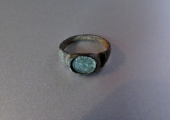 A bronze finger ring with a moulded glass “jewel” that was found in the garden of a house on Tory, Bradford on Avon. The site is just below Budbury, where Roman items, including some jewellery, have been found before.
A bronze finger ring with a moulded glass “jewel” that was found in the garden of a house on Tory, Bradford on Avon. The site is just below Budbury, where Roman items, including some jewellery, have been found before.
.A bronze bow brooch

